As the golden sun sets over the picturesque landscapes of southwestern Turkey, a hidden gem awaits those seeking a blend of natural wonders and ancient marvels. Pamukkale and Hierapolis, a captivating duo that beckons travelers from far and wide, offer an experience like no other.
Like a delicate tapestry woven by Mother Nature herself, Pamukkale’s terraces of petrified lime cascades stand as a testament to the passage of time. But there is more to this enchanting destination than meets the eye.
Hierapolis, an ancient Roman city steeped in history, unveils its secrets to those who dare to explore its ruins.
Intrigued? Join us as we embark on a journey to discover the captivating tales that lie within the depths of Pamukkale and Hierapolis.
Good To Know
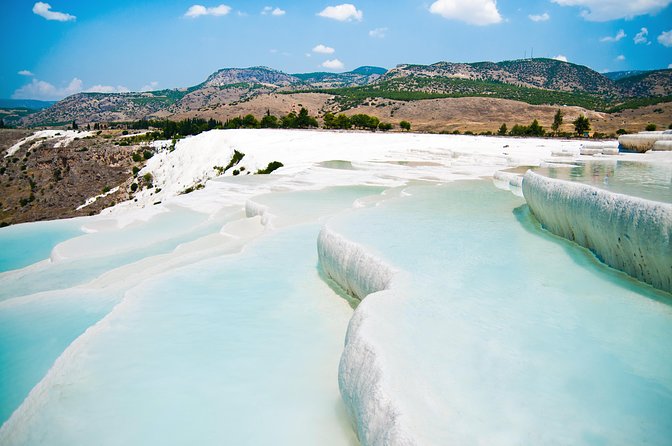
- Pamukkale is a natural wonder with stunning petrified lime cascades and calcium-rich thermal water formations.
- Hierapolis is an ancient Roman city known for its impressive ruins, including the Theater and the Necropolis.
- The tour includes visits to significant sites such as the Apollo Temple, the Theatre, and the 4th-century basilica.
- Traveler experiences vary, with some expressing disappointment in the condition of Pamukkale, the tour guide’s performance, and limited time at the sites, while others enjoyed the unique experience, swimming opportunities, and recommended visiting Pamukkale to others.
Natural Wonder: Petrified Lime Cascades
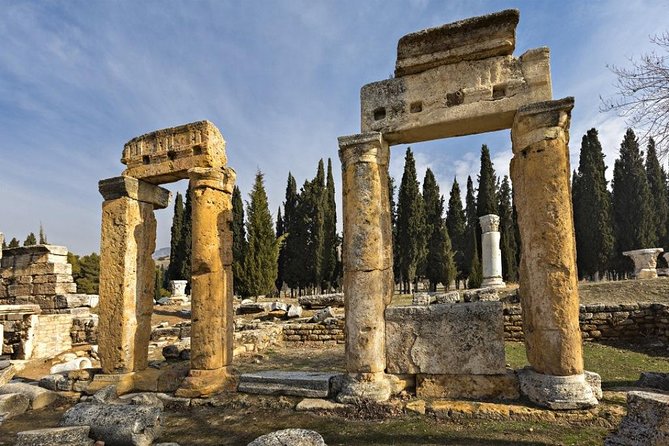
Pamukkale boasts a natural wonder that will leave visitors in awe: petrified lime cascades that create a breathtaking and unique landscape. These petrified lime formations are the result of millions of years of geological processes.
It all began when hot mineral-rich water from underground springs flowed down the hillside, depositing calcium carbonate. Over time, these deposits built up and formed terraces of white, petrified lime. The cascades are constantly changing as the water flows and deposits new layers of calcium carbonate.
The geological processes that created these formations are fascinating and can be seen in the intricate patterns and textures of the petrified lime. Visitors to Pamukkale can marvel at this natural wonder and gain a deeper appreciation for the forces of nature that shaped it.
Find more activities and experiences we've covered in Izmir.
Ancient Roman City: Hierapolis
Hierapolis, an ancient Roman city built during the 2nd century AD, offers visitors a fascinating glimpse into the rich history and architectural wonders of the past.
The city is renowned for its remarkable Roman architecture, showcasing the ingenuity and grandeur of the time.
Hierapolis holds great historical significance, as it was a thriving center of trade and culture in the region.
The city boasts impressive structures, including the Theater, where performances were held for thousands of spectators, and the Necropolis, which is the largest ancient graveyard in Anatolia.
Exploring Hierapolis allows visitors to enjoy the magnificence of the Roman Empire and gain a deeper understanding of its influence on the region.
Highlights: Theater and Necropolis
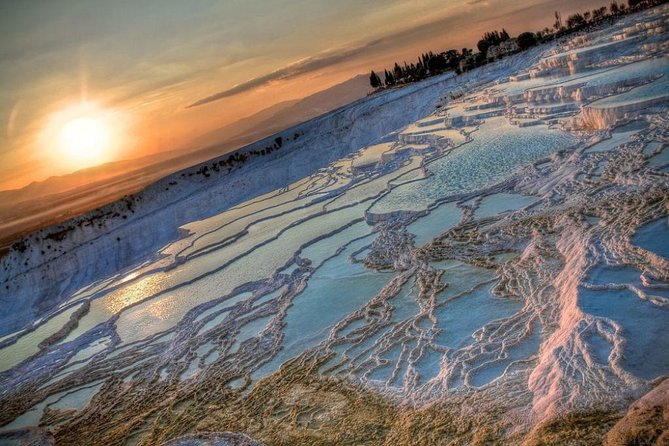
As visitors explore Hierapolis, they’ll be captivated by the remarkable Theater and the awe-inspiring Necropolis, seeing the grandeur and historical significance of these ancient Roman structures.
The Theater of Hierapolis is a magnificent amphitheater that once hosted performances and gatherings. With a seating capacity of approximately 15,000 spectators, it stands as a testament to the city’s cultural and artistic heritage.
The Necropolis, on the other hand, is the largest ancient graveyard in Anatolia. Stretching over a vast area, it contains thousands of tombs and sarcophagi, showcasing the rich history and customs of the people who lived in Hierapolis.
Exploring these sites not only offers a glimpse into the past but also highlights the historical significance of theater and burial practices in ancient Roman society.
Stunning Views: Water Trickling Over White Limestone Tubs
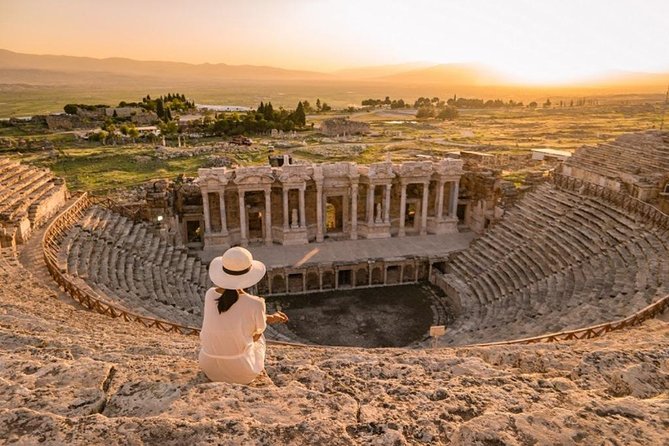
Visitors to this remarkable destination are greeted with a breathtaking sight: water delicately trickling over the smooth white limestone tubs, creating a mesmerizing display of natural beauty.
Pamukkale’s stunning views are the result of the calcium-rich thermal water that flows down the terraces, forming cataracts, stalactites, and basins.
Beyond its visual appeal, Pamukkale also offers a unique swimming experience. Travelers can enjoy the warm waters of Cleopatra’s Pool, surrounded by sunken columns from ancient times.
However, the impact of tourism on this natural wonder can’t be ignored. The increased number of visitors has led to concerns about the preservation of the site. Efforts are being made to manage tourism sustainably and protect the fragile ecosystem of Pamukkale.
Despite these challenges, the opportunity to witness the water trickling over the white limestone tubs is a sight that shouldn’t be missed.
Calcium Deposit Pools: Cataracts, Stalactites, and Basins
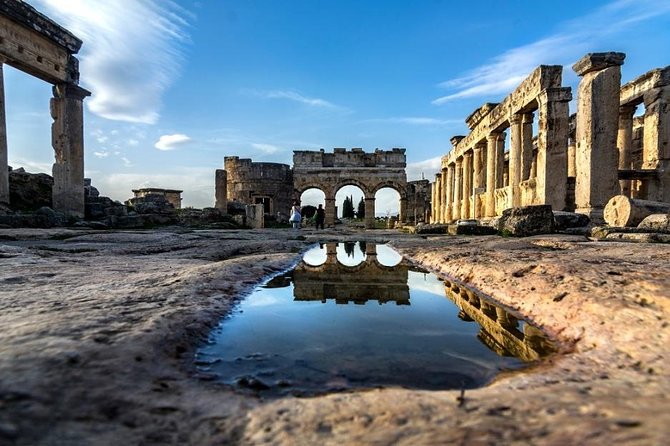
The calcium-rich thermal water at Pamukkale creates a stunning display of cataracts, stalactites, and basins, forming unique and captivating calcium deposit pools. These geological formations are a sight to behold, attracting visitors from all over the world.
Here is what you can expect to see at these extraordinary pools:
- Cataracts: Imagine water cascading down in a series of small waterfalls, creating a mesmerizing effect.
- Stalactites: Picture icicle-like formations hanging from the edges of the pools, adding a touch of beauty and wonder.
- Basins: Visualize shallow pools of milky turquoise water, inviting you to take a refreshing dip.
Not only are these calcium deposit pools visually stunning, but they also possess therapeutic properties. The warm water is believed to have healing benefits for various ailments, making it a popular destination for wellness seekers.
Spectacular Roman Ruins and 4th-Century Basilica
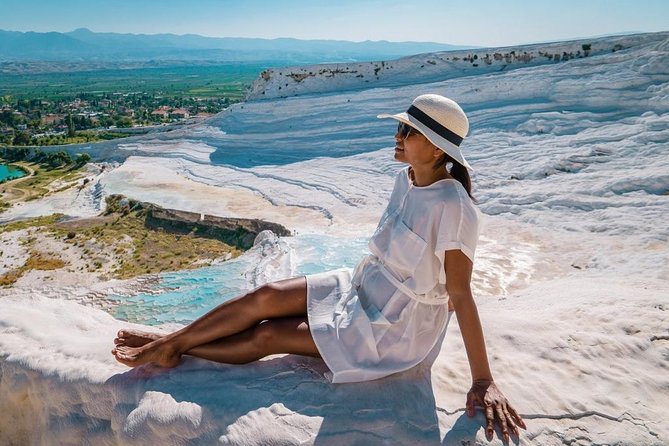
The Roman ruins at Pamukkale and the 4th-century basilica provide visitors with a captivating glimpse into the rich history and architectural grandeur of this ancient site. The ruins, with their spectacular structures and historical significance, transport travelers back in time to the days of the Roman Empire. The 4th-century basilica, in particular, stands as a testament to the artistic and engineering skills of the era. Its intricate design and intricate mosaics are a sight to behold. To further illustrate the magnificence of these ruins, a three-column, three-row table is presented below. This table showcases the various aspects of the Roman ruins and the 4th-century basilica, highlighting their grandeur and historical importance.
| Aspect | Description | Emotion |
|---|---|---|
| Architectural Splendor | Magnificent structures and design | Awe-inspiring |
| Historical Significance | Connection to the Roman Empire | Fascinating |
| Cultural Heritage | Preserving the past | Appreciative |
Visiting these ruins and the basilica is an opportunity to explore the past and appreciate the skill and artistry of the ancient Romans. The experience is sure to leave visitors in awe and with a deeper understanding of the historical legacy of Pamukkale and Hierapolis.
Traveler Experience and Reviews
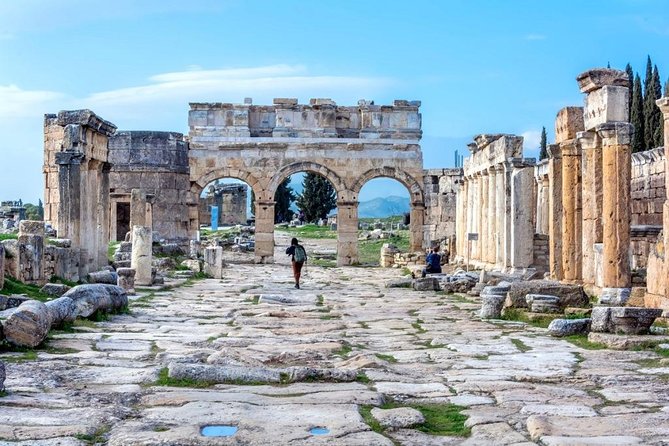
Now let’s shift our focus to the experiences of travelers and their reviews of Pamukkale and Hierapolis. Traveler satisfaction plays a crucial role in determining the success of any tourist destination, and the performance of tour guides can greatly influence this. Here are some key points to consider:
Mixed reviews: Travelers have expressed both positive and negative experiences during their visit to Pamukkale and Hierapolis.
Tour guide performance: Some visitors praised the knowledgeable and fun tour guide, while others were disappointed with the lack of information provided.
Desire for more time: Many travelers wished they’d more time to explore the sites, indicating their interest and enjoyment.
Recommendations: Despite some drawbacks, several reviewers recommended visiting Pamukkale, emphasizing its unique and beautiful qualities.
It is important to note that traveler satisfaction can vary based on individual expectations and preferences. The majority of reviews highlight the captivating nature of Pamukkale and the historical significance of Hierapolis.
Common Questions
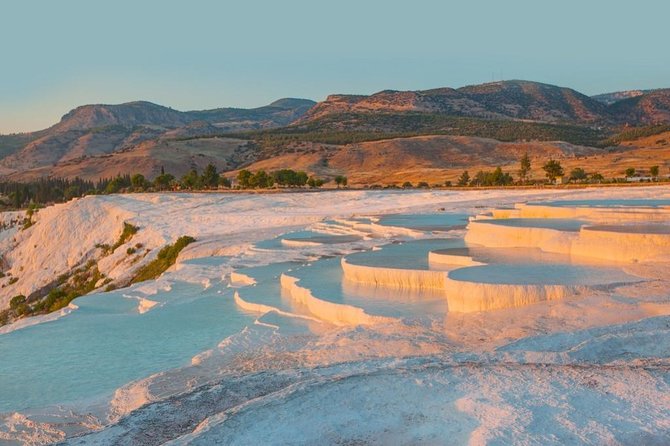
What Is the Best Time of Year to Visit Pamukkale and Hierapolis?
The best season to visit Pamukkale and Hierapolis is during the spring or fall when the weather is mild and the crowds are smaller. Popular attractions include the stunning calcium deposit pools and the ancient Roman ruins.
Can You Swim in the Calcium Deposit Pools at Pamukkale?
Yes, visitors are allowed to swim in the calcium deposit pools at Pamukkale. Swimming in these pools has many benefits, such as the mineral-rich water being good for the skin and providing a unique and refreshing experience.
How Long Does It Take to Explore Hierapolis?
Exploring Hierapolis can take several hours, depending on the level of sightseeing desired. Visitors can spend time marveling at the Roman ruins, visiting the theater and basilica, and exploring the Necropolis, making for a fulfilling and immersive experience.
Are There Any Restrictions or Guidelines for Swimming in Cleopatra’s Pool?
Swimming rules in Cleopatra’s pool and safety precautions for swimming in Cleopatra’s pool can vary depending on the location. It’s important for visitors to follow any guidelines provided by the authorities to ensure a safe and enjoyable swimming experience.
What Are Some Alternative Transportation Options for Reaching Pamukkale From Izmir?
Bicycle tours and private car hire are popular transportation options for reaching Pamukkale from Izmir. They provide flexibility and convenience, allowing travelers to explore the area at their own pace.
The Sum Up
To sum it up, Pamukkale and Hierapolis are truly extraordinary destinations that offer a unique blend of natural beauty and ancient history.
From the captivating petrified lime cascades in Pamukkale to the awe-inspiring ruins of Hierapolis, these sites provide a mesmerizing experience for travelers.
Whether you’re drawn to the natural wonders or the historical marvels, a visit to Pamukkale and Hierapolis is sure to leave you with unforgettable memories.
Don’t miss out on the chance to explore these remarkable destinations.
More Tour Reviews in Izmir
- Izmir to Aphrodisias: Cooking & Ceramics Class
- Seven Churches of Revelation Tour
- Customized Ephesus Private Tour / FOR CRUISE GUESTS ONLY
- Private Ephesus & House of Virgin Mary, Izmir Port /cruisers only
- Ephesus Highlights Tour: Exclusive for Cruise Guests
- Independent Pamukkale Tour From Izmir With Hot Air Balloon Flight
Looking for something different? Other Izmir activities we've written about
- Izmir to Aphrodisias: Cooking & Ceramics Class
- Seven Churches of Revelation Tour
- Customized Ephesus Private Tour / FOR CRUISE GUESTS ONLY
- Private Ephesus & House of Virgin Mary, Izmir Port /cruisers only
- Ephesus Highlights Tour: Exclusive for Cruise Guests
- Independent Pamukkale Tour From Izmir With Hot Air Balloon Flight
- Ephesus Tour From Izmir (Best Seller)
- Ephesus Ancient City with Best Guides Only For Cruise Guests
- From Izmir: Ephesus Ancient City Day Tour w/Lunch
- From zmir Port : zmir City Tour – Colors of Izmir
- From Izmir: Pamukkale, Hierapolis and Karahayit Day Tour
- Ephesus Port: Private Guided Customizable Tour
